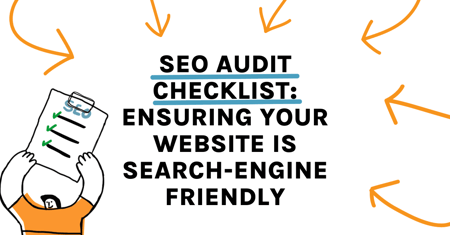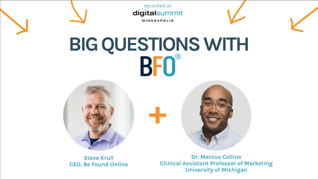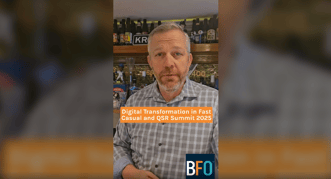SEO Audit Checklist: Ensuring Your Website is Search-Engine Friendly
August 14, 2024
13 Minute Read

Ever feel like your website is a hidden gem? At BFO, that’s the last thing we want. What do we want? Exactly what our name declares—for you to be found online. But if you feel like your website just isn’t getting the love it deserves from search engines, we understand.
It can be incredibly frustrating to spend time and money creating a stellar website only to find it's buried deep in the search results. Our team has seen this scenario play out time and time again.
That's why we're providing you with an SEO audit checklist, so you can navigate the intricate maze that is SEO. From technical tweaks to on-page optimization, we’re covering it all below. Take a look so you can ensure your website is search engine friendly!
Table of Contents:
- Technical SEO Audit
- On-Page SEO Audit
- Off-Page SEO Audit
- User Experience Audit
- Local SEO Audit
- Analytics & Reporting
Technical SEO Audit
First things first, your website needs to be easily crawlable by search engines. If search engines can't access your pages, they can't rank them (yikes). This is where technical SEO comes in!
- Crawling Tools: The right agency will use tools to crawl your website. These tools will mimic how search engines navigate your site, identifying any issues that might impact your crawlability.
- Setup Google Search Console and Bing Webmaster Tools: Google Search Console (GSC) and Bing Webmaster Tools are free tools that help you monitor and optimize your site’s performance in search results. They provide insights into keywords, crawling issues, and more. If you haven’t set them up yet, we strongly recommend doing so.
- Crawl Errors: Uncovering crawl errors can help identify broken links (that lead to those pesky 400-level errors), 500-level server errors, issues with redirect chains, duplicate canonical tags, and more. These website issues not only disrupt user experience but also waste crawl budget, and no user likes landing on a 404 error page.
- Robots.txt: Make sure your robots.txt file is properly configured. This file tells search engines which pages to crawl and which to avoid. Make sure it's not blocking any important pages.
- XML Sitemap: Reviewing your website's XML sitemap ensures it accurately reflects your site's structure and content for the best search engine visibility possible.
URL Structure
A clean, detailed URL structure is essential for both users and search engines.
- Descriptive URLs: Use clear, descriptive URLs that include relevant keywords. Avoid long, confusing strings of numbers and symbols (ain’t nobody got time for those).
- Consistency: Maintain a consistent URL structure across your site. This helps search engines understand the hierarchy and organization of your content.
- Avoid Duplicates: Ensure there are no duplicate URLs and update them should you come across any.
Site Speed and Performance
Site speed is a major ranking factor and significantly impacts user experience.
- Measuring Tools: Your agency should have a handful of tools they can use to measure your site's speed and performance.
- Optimizing Images: Compress and optimize images to shorten any annoying load times. Use formats like WebP for better performance.
- Minimize HTTP Requests: Reduce the number of HTTP requests by minimizing the use of unnecessary scripts and combining files where you can.
- Enable Caching: Use browser caching to store static files so they don’t need to be reloaded every time a user visits your site.
Mobile-Friendliness
With the majority of web traffic coming from mobile devices, making your site mobile-friendly is a non-negotiable in today’s marketing world.
- Responsive Design: Confirm your site uses a responsive design that adapts to different screen sizes. Test across multiple devices to make sure the experience is good regardless of where people are checking out your content.
- Touch Elements: We’ve all been frustrated with a button we can’t click—make sure your buttons and links are large enough to be easily clickable on a touch screen.
On-Page SEO Audit
Now that we’ve tackled the technical side of things, it’s time to focus on on-page SEO. This involves optimizing individual pages to make them more search-engine friendly. Let’s break down the key elements you need to check out.
Title Tags and Meta Descriptions
Title tags and meta descriptions play a big role in attracting clicks from search engine results pages (SERPs).
- Unique and Descriptive Title Tags: Each page should have a unique title tag that accurately describes the content (no click-bait here!). Include primary keywords but keep it natural and concise, ideally under 60 characters.
- Compelling Meta Descriptions: Write meta descriptions that summarize the page content and entice users to click (again, without implementing any shady click-bait strategies). Aim for around 150-160 characters and include relevant keywords.
- Avoid Duplicates: Make sure each title tag and meta description is unique to improve clarity for search engines.
Header Tags (H1, H2, H3, etc.)
Header tags help structure your content and make it easier for users and search engines to understand.
- H1 Tags: Use one H1 tag per page to indicate the main topic (like we did here!). This should include your primary keyword.
- Subheadings: Use H2, H3, and other subheadings to organize content into sections. This improves readability and helps search engines understand your content hierarchy.
- Keyword Usage: Incorporate keywords naturally into header tags without keyword stuffing.
Keyword Optimization
Optimizing your keywords ensures your content aligns with what users are searching for (aka, it ensures your dream customers find you online!).
- Keyword Research & Mapping: Conduct keyword research to find relevant keywords with a good balance of search volume and competition. Keyword mapping is a key component of on-page optimizations and content strategies. Having your target keywords mapped correctly can help you discover where the appropriate place to optimize for a keyword is, what supporting content may be needed, or what new pages to consider creating to help improve organic rankings.
- Keyword Placement: Put primary keywords in strategic locations, such as the title tag, first paragraph, headers, and throughout your content.
- Natural Integration: Ensure keywords are integrated naturally within your content to make things easy to understand and avoid penalties from search engines. Gone are the days when you could stuff keywords anywhere you want—they actually need to make sense now!
Structured Data/Schema
Schema or structured data is a standardized format for organizing and annotating web content so that search engines can understand it better, leading to more relevant search results. It is important for SEO because it can enhance the visibility of a website in search results, potentially increasing click-through rates and driving more traffic to the site."
Some examples of Schema types include:
- Product Schema: Perfect for ecommerce companies or businesses who display shoppable products on their website.
- FAQ Schema: Does your website have a frequently asked questions page? If so, using FAQ Schema will make that clear to search engines!
- LocalBusiness Schema: If you’re a local business or a company trying to show up in a specific geographic area when people are searching for things like “best pizza in Chicago,” this is the type of Schema you should be looking to implement.
- Article Schema: Content such as news, blogs, and spots article pages can be more easily searchable in search engines with Article Schema.
- Video Schema: Can you guess what this one does? Make the videos on your website more clear to search engines with Video Schema. It’s the least you can do for all the time that goes into video production!
- Breadcrumb Schema: If there’s a hierarchy that users should be moving along on your website, Breadcrumb Schema can help make that path clear when your website is crawled.
Content Quality and Relevance
High-quality, relevant content is critical for engaging users and ranking well in search engines.
- Original and Valuable Content: Ensure your content is original, provides value, and addresses the needs of your audience.
- Content Length and Depth: Aim for detailed content that thoroughly covers the topic. Longer content tends to rank better, but quality over quantity is key.
- Multimedia: Use images, videos, and infographics to enhance content and provide a better user experience. Just be sure to also optimize these elements for SEO.
- Internal Linking: Use internal links to connect related content within your site.
Off-Page SEO Audit
Having optimized your website’s on-page elements, it’s time to step outside and focus on off-page SEO. This means boosting your website’s reputation by leveraging external factors, which we dive into below!
Backlink Profile
Backlinks, or inbound links, are a big factor in how search engines evaluate your site's relevance. Quality backlinks from relevant sites signal to search engines that your site is trustworthy and worth the click.
- Analyzing Backlink Profile: Work with a digital marketing agency to analyze your backlink profile. Look at the number of backlinks, the quality of linking domains, and anchor text distribution.
- Identifying Toxic Links: Find and get rid of toxic or spammy links that could hurt your site's reputation.
- Building High-Quality Backlinks: Focus on adding backlinks from high-authority sites in your niche. Strategies include guest blogging, influencer outreach, and creating shareable content like infographics.
Social Media Signals
Social media activity can indirectly influence your SEO by driving traffic and increasing visibility.
- Social Media in SEO: While social signals aren’t a direct ranking factor, a strong social media presence can lead to more backlinks and traffic, which benefit SEO.
- Optimizing Social Profiles: Make sure your social media profiles are complete and consistent. Use relevant keywords and include links back to your website.
- Content Sharing: Encourage social sharing of your content by including share buttons on your site.
User Experience (UX) Audit
In addition to technical and content optimizations, a vital part of ensuring your website is SEO-friendly is providing an awesome user experience (UX). Search engines prioritize websites that offer great UX, as this usually indicates valuable content and happy users.
Navigation and Site Structure
Clear navigation helps users find what they need quickly and easily, which is essential for both UX and SEO (not to mention lead generation!).
- Intuitive Navigation: Ensure your website’s navigation is straightforward. Main menus should be easy to find and understand.
- Breadcrumbs: Implement breadcrumb navigation to help users understand where they’re at within your site and easily return to previous pages.
- Site Hierarchy: Organize your content in a clear hierarchy with categories and subcategories. Use internal linking to connect related content and help users explore your site.
Readability and Design
A thumb-stopping design and readable content keep users engaged and reduce bounce rates.
- Font and Formatting: Use legible fonts and appropriate font sizes. Break content into short paragraphs and use bullet points for easier reading.
- White Space: Incorporate white space to avoid clutter and make your content more digestible.
- Visual Elements: Use images, videos, and graphics to complement your content and make it more engaging. Just be sure these elements are optimized for fast loading times!
Local SEO Audit
For businesses targeting a local audience, optimizing for local SEO is a game-changer. It ensures your business appears in local search results, reaching customers who are looking for services or products in your area.
Google Business Profile (Formerly Google My Business)
Google Business Profile (GBP) is the MVP for local SEO. An optimized GBP profile can significantly boost your visibility in local searches.
- Claim and Verify Your GBP Listing: Make sure you’ve claimed and verified your business.
- Complete Your Profile: Fill out all the information fields accurately, including your business name, address, phone number (NAP), website, business hours, and categories.
- Add High-Quality Photos: Upload high-quality images of your business, products, or services to create a more engaging profile.
- Manage Reviews: Encourage happy customers to leave reviews on your GBP profile. Respond to all of them, both positive and negative, to show that you value customer feedback.
- Regular Updates: Keep your GBP updated with any changes to your business hours, special events, or new offers.
Local Citations
Local citations are online mentions of your business’s NAP information on different websites and directories. Consistent citations help build credibility and improve local search rankings.
- Consistency is Key: Ensure your NAP information is consistent across all local directories, social media profiles, and your website. We’ve all called a number or clicked a link only to find out it’s not what we were looking for—so don’t be that guy!
- Key Local Directories: Submit your business to key local directories such as Yelp, Yellow Pages, and Bing Places.
- Monitor and Update: Regularly monitor your local citations for accuracy and update any outdated or incorrect information.
Analytics and Reporting
You've put in all this work to step up your SEO game—so let’s make sure it’s worthwhile! Analytics will help you track your performance and make data-driven decisions (ensuring you don’t waste time or money).
- Account Setup: Create a Google Analytics account if you don’t already have one. Follow the setup process to link your website.
- Install Tracking Code: Install the Google Analytics tracking code on all pages of your website. This code collects data about your visitors and their interactions. Don’t have time to do so? Your agency should do this for you!
- Goals and Conversions: Set up goals to track important actions on your site, such as form submissions, product purchases, or newsletter sign-ups. This helps measure the effectiveness of your SEO in encouraging people to take action.
- Filters and Views: Create different views with filters to exclude internal traffic and spam.
Monitoring and Reporting
Regular monitoring and reporting are how you’ll see if your SEO efforts are impacting your website’s performance. Here are some key metrics to track:
- Organic Traffic
- Bounce Rate
- Average Session Duration
- Pages per Session
- Conversion Rate
All of these can be found inside your Google Analytics database.
Final Thoughts
Phew! You made it through our comprehensive SEO audit checklist. By now, you should have a solid understanding of the key areas to focus on to ensure your website is search-engine friendly.
Need a hand implementing all of these things? We don’t blame ya. Check out our SEO services here, or send us a message with your questions!
Want to stay up to date on all things SEO? Sign up for our monthly newsletter below!

Jon Pappas
Jonathon is the Director of Organic Search at BFO. He’s a reliable and consistent member of our team and is very detail-oriented and client-focused.
CATEGORIES
SUBSCRIBE TO OUR BLOG
Stay up to date with the latest industry best practices in digital marketing!




























.png?width=339&height=179&name=Webinar%20Banner%20(1).png)



.png?width=339&height=179&name=July%20Webinar%20(Newsletter).png)

.png?width=339&height=179&name=Webinar%20Banner-April-02%20(1).png)
%20(4).png?width=339&height=179&name=Webinar%20Banner-May-02%20(1)%20(4).png)




.png?width=339&height=179&name=March%202023%20Webinar%20Ad%20(autoresponder).png)






























































